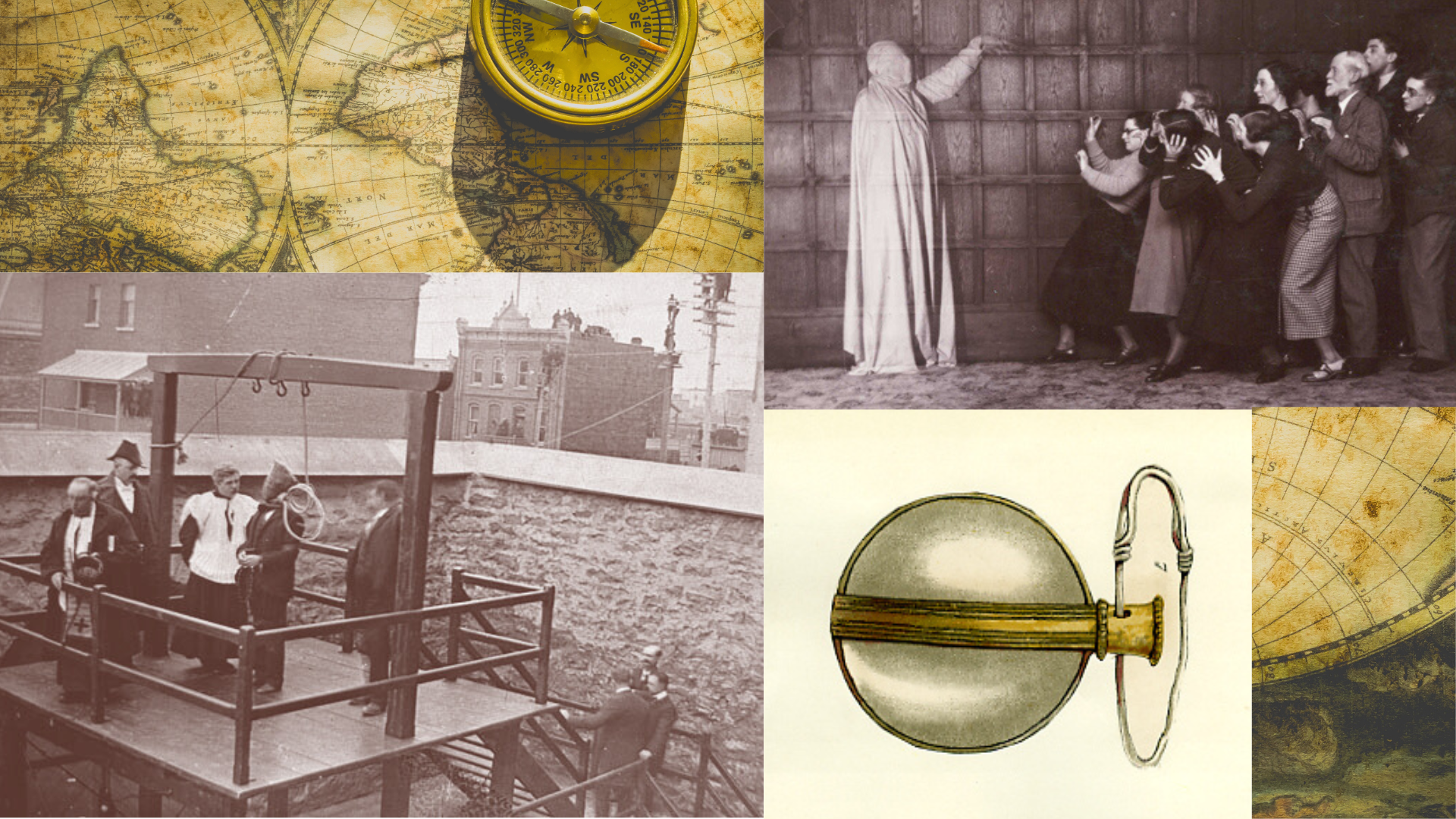Dr. Sara Ann Knutson is an Assistant Professor of teaching in the Department of History. One of her courses in the 2024/2025 academic year is HIST_V 101: Global History Before 1500 CE, a survey course that introduces students to the practice of History, providing a critical framework for understanding how people in the past understood the world around them. HIST_V 101 also focuses on making sense of the past through connections, exchanges, and interactions, such as the spread of language, religion, cultural practices, and the movement of goods, animals, and people across the world.
In celebration of International Women’s Day on March 8, here’s a list of the contributions of women to global history, inspired by course materials featured in HIST_V 101. Read on to learn about powerful women like Enheduanna of ancient Sumer (2285 – 2250 BCE) and Mongol noblewoman Qutulun (c. 1260 – c. 1360 CE), as well as the critical roles women played in global trade networks, human migration, and the spread of culture and language around the world and across continents.
The Exaltation of Inanna by Enheduanna (2285 – 2250 BCE)
Sumerian tablets inscribed with Cuneiform. Housed in the Yale Babylonian Collection. Photo by Klaus Wagensonner. Image via the Yale University Press.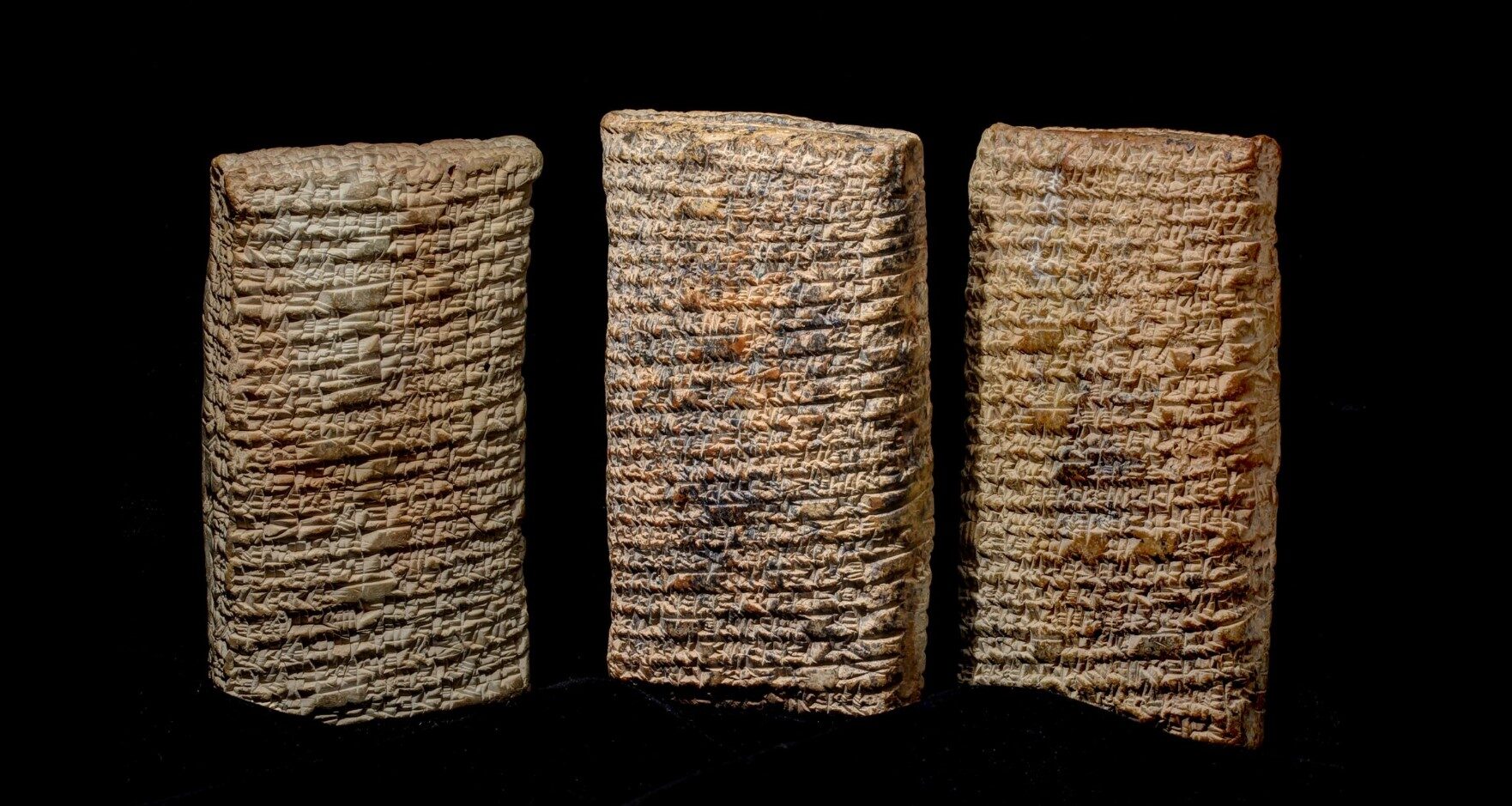

The Exaltation of Inanna is an epic poem attributed to Enheduanna (2285 – 2250 BCE), the high priestess of the moon (Nanna). She was appointed by her father Sargon of Akkad, who was the ruler of the Sumerian city-state Ur (c. 3800 BCE – 500 CE). Exaltation was composed in cuneiform, a writing system that was used throughout the Land of Two Rivers for almost 3000 years and was widely adapted by cultures in ancient Sumer and Babylon (Knutson 1.3). After Sargon of Akkad conquered Sumerian cities, he created a capital city named Akkad and united the region through the Akkadian language, which adapted cuneiform as its writing system . Cuneiform was adopted by several pre-modern cultures throughout history. The first use of cuneiform known to historians was in Ancient Sumer in 3000 BCE, at which point it was used for recording taxes, inventories, and payments. As one of the first epic poems known to history, Exaltation marks a significant turning point where written language expands beyond a tool for record-keeping and becomes a way to record creative and abstract ideas that become literature.
The poem has 154 lines. In the first 65, the poet details the formidable and terrible power of the goddess Inanna and the influence of her whims not only on human affairs, such as war and intra-marital affairs, but also in natural (and unnatural) disasters, such as the success of crops (Black et al. 1999). The poem pivots in line 66 when the author introduces herself as Enheduanna, the priestess in the holy service of Inanna. The author then details in lines 91-108 how she was expelled from Ur by a usurper, who made her “walk the thorn bushes of the mountains, stripped [her] of [her] rightful crown,” and “gave [her] a knife and dagger, saying to [her] ‘These are appropriate ornaments for you,’" insinuating she should end her own life (Black et al. 1999). For the rest of the poem, the author aligns her own anguish at having been expelled with the powers of Inanna, appealing to divine intervention to restore power to herself and the Sargonian empire. In effect, the author rhetorically intertwines her own right to rule with divine power while immortalizing the illegitimacy of the rule of the usurper. When Enheduanna invokes the power of Inanna, she not only appeals to Inanna as herself, but as a deity in relation to other powerful gods. For example, in the poem, Inanna is invoked as “precious lady, beloved by An” (line 109), “eldest daughter of Suen,” (line 41), and “beloved spouse of Ucumgal-ana” (line 109). Similarly, the author does not simply refer to herself as Enheduanna, but as the “priestess of Nanna” (line 121). This suggests that beyond its function as a rhetorical tool, relationality may lend legitimacy to power in Akkadian culture. As a woman and the first known author to history, Enhedunna’s perspectives and experiences are passed down through her rhetorical choices that have been studied and emulated by writers from cultures across time and geographies. During a time in which reading and writing were reserved for a privileged few, it is significant that Enheduanna’s work has been studied, preserved, and revisited for centuries after her time. On a global scale, the spread and adaptation of written language by different cultures is important to global history on at least two levels. Firstly, written language facilitates and records the exchange of culture by conveying different ideas, knowledge, and religious and cultural practices across different societies. For modern historians, it establishes touchpoints for the connections, trade, and other interactions between cultures spread across geography. Secondly, the adaptation of the written language system itself is a form of cultural exchange - Sumerian literary works such as The Exaltation of Inanna were widely studied throughout history by scholars from other geographies and time periods, including scribes from the First Babylonian Empire, who lived more than a thousand years later, and even modern day scholars and rhetoricians.
Woman’s Crown, Tillya Tepe (100 BCE)
Crown from the Tillya Tepe, Tomb VI, 1st century BC - 1st century AD. Crown is gold and imitation turquoise Thierry Ollivier / Musée Guimet. Image via Smithsonian Magazine.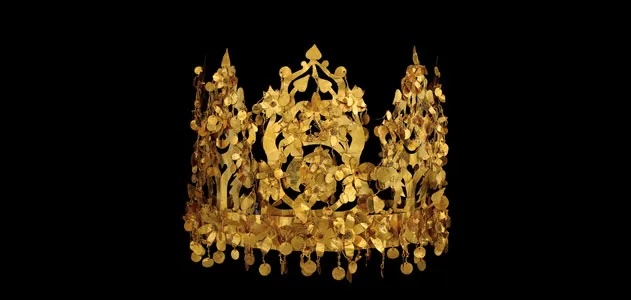

This entry shows a woman’s crown uncovered from Tillya Tepe, an archaeological site located in modern-day northern Afghanistan. Dating to the first century BCE, Tillya Tepe is a collection of six burial mounds containing 20,600 artefacts, including figurines, coins, belts, crowns, and jewelry made of gold, silver, ivory, and semi-precious gemstones, such as turquoise (Knutson 1.6). Tillya Tepe literally translates to “golden mound”, and the collection found here is often known as the Bactrian gold.
The crown itself is made of gold and what appears to be turquoise, which are materials that are significant to trade in global history. Notably, turquoise originates from Iran, Tibet, China, and Kazakhstan, and is not local to Bactria. Its presence at Tillya Tepe is evidence of the movement of raw materials to other regions of the world via routes of the Silk Road networks. Additionally, the visual culture depicted by the figurines in the collection demonstrate the spread of Hellenization, which is the influence of Greek culture in other parts of the world. During and after the rule of Alexander the Great (336 - 323 BCE), the Greeks often sent their prisoners of war to Bactria. Over time, Greek became a commonly spoken language in the region in addition to Bactrian, an Eastern Iranic language. Further, this forced human migration led to the incorporation of Greek visual culture and Greek loanwords into Bactrian culture and the Bactrian language respectively. This is another example of the spread and exchange of cultures important to global history. Hellenization, however, is not the only evidence of cultural and material exchange at Tillya Tepe. “These nomads took iconography from Greece, Rome, China, India, even as far away as Siberia, and put it together into their own unique and highly refined art style," says Fredrik Hiebert, archaeologist and guest curator of an exhibition that showcased items from Tillya Tepe, who suspects there were workshops buried near the tombs (Hiebert, quoted in Covington, 2008). Hiebert’s insight suggests not only did the owners of the burial mounds collect materials and goods from across the silk road network, they actively collected styles and visual elements they liked, and instilled them into brand new artifacts. Interestingly, the semi-precious stone found in the crown is, in fact, imitation turquoise (Covington, 2008), while plenty of other artifacts at Tillya Tepe, such as daggers and sheaths, were crafted using authentic turquoise. The use of imitation turquoise suggests the crafts people knew turquoise existed, but were unable to obtain them for use at the time. This suggests that while the exchange and moment of materials across silk road networks were undoubtedly important, the exchange and spread of ideas and visual cultures were sometimes even more important than the material itself. The burial mounds at Tillya Tepe, for five women and one man, demonstrate women were consumers of material goods and culture in Bactria during this time. The collection is a reminder that the spread, exchange, and movement of material goods and culture we study in the context of global history is rarely random, and often driven by individual interest in items and ideas from other parts of the world. Such interest, especially from historical actors who had access to abundant power and wealth, is a considerable force behind the value instilled in select materials, objects, and ideas that enabled them to spread further than others. Much like Miranda Priestly in The Devil Wears Prada, whose taste in seasonal fashion dictates the clothing items and choices that trickle down to the masses, those who had the power and wealth of choice throughout history, like the woman owners of the burial mounds, were able to assign value to visual cultures based on their own preferences. While it is unclear whether their preferences trickled down to the masses during their time, the material collections they left behind contribute to present-day understandings of how materials and ideas spread from one part of the world to another.
Eighteen Songs of a Nomad Flute by Liu Shang, and the Story of Lady Wenji (c. 170 – 215 CE)
Cai Wenji's departure from China. Courtesy of the Metropolitan Museum of Art, New York.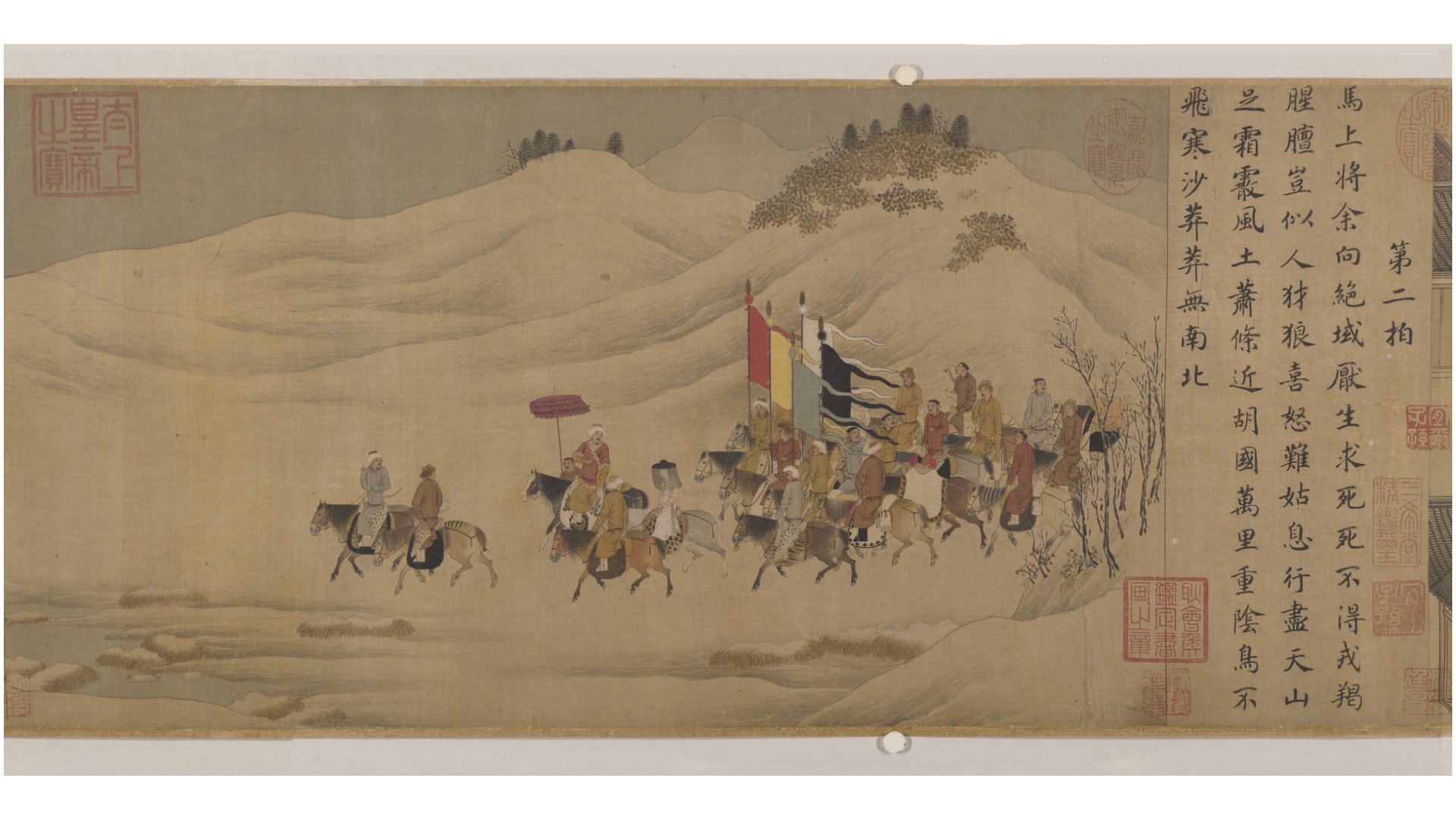

Eighteen Songs of a Nomad Flute tells the story of Lady Wenji, or Cai Yan, a Eastern Han Dynasty poet, scholar, and musician. She was abducted by the Xiongnu in 195 CE and lived among them for 12 years. Eighteen Songs, a 40-feet scroll of 18 painted scenes accompanied by poetic retellings of her life penned by Liu Shang in the 8th century CE (Andrea and Overfield, 263). It was inspired by poems Lady Wenji composed about her life among the Xiongnu.
Despite the fact that Lady Wenji was herself a poet and scholar, who had written about her own experiences, the version remembered by history that commemorates her life is a retelling of her story by a man, some 600 years later. In the context of the relationship between the Han and Tang Dynasties and the Xiongnu, respectively, and in the larger context of global history, Lady Wenji’s life story is useful as a cultural narrative, in which the Tang Dynasty were able to distinguish themselves from surrounding cultures, like the Xiongnu, with whom they are often in tension. Women like Lady Wenji, who migrated to live in other cultures, whether voluntarily or forced by circumstance, contribute to the movement of culture, goods, and different ways of understanding the world. The part of the scroll featured above is the second of the eighteen songs, as titled on the right. In this painting, Lady Wenji is on horseback, riding sidesaddle. She wears a light-coloured outfit with a black hat with face covering, and like some of the other riders in the painting, her saddle is spotted, as if made of leopard skin. Lady Wenji is flanked by two other riders, one per side, both of whom are turned towards her, as if speaking to her. Riding behind Lady Wenji is a group of men. True to the name of the scroll, there appear to be two flutists among the group. Additionally, there seems to be a falconer to the top edge of the group, who has a falcon on his right arm. The inclusion of these details suggest a Chinese fascination with the material goods, culture, and practices of their nomadic neighbours. The story of Lady Wenji is a record of an instance of human migration between Han Dynasty China and Xiongnu, in the second century CE. It is also a testament to the long, and often complex relationship between Chinese sedentary societies and nomadic peoples, many of whom did not leave written records from their own perspectives. Liu Shang created Eighteen Songs based on Lady Wenji’s life in the 8th century CE during the Tang Dynasty, roughly 600 years since the subject’s time. The Tang Dynasty was at the height of its power in the 8th century CE, but we also know the relationship between the Chinese dynasties and the Xiongnu was complex, ongoing, and fluctuated between peaceful and tumultuous (Knutson 1.8). Politically, Lady Wenji’s life becomes a metaphorical seed from which narratives of cultural identity are told and retold, even centuries later, where her stories germinate as symbolic vessels for the larger histories of contention and conflict between Chinese dynasties and nomadic cultures.
Statues from Oyo (1100 – 1500 CE)
Image left: photograph courtesy of the Library of Congress. Image right: Seated figure with sword, Esie, before 1850 (soapstone), Nigerian/Private Collection. Photo by Dirk Bakker. Image via The Bridgeman Art Library.

The Yoruba-speaking people of west Africa were known for their art and state building. One example of their artistic mastery is a collection of more than a thousand soapstone statues found in the town of Elsie in modern day Nigeria. These statues are portraits of prominent and likely deceased members of their society, each about two feet tall, and date to between 1100 and 1500. They either originate from the city-state of Old Oyo or Ile-Ife (Andrea and Overfield 356).
The individuals depicted in these portraits are likely those who held important positions in society. They include men, women, and possibly other genders (356), suggesting people of all genders held venerated roles in Yoruba society at Oyo and/or Ife. In particular, one of the depicted figures appears to be a woman holding a weapon against her right shoulder. Some scholars suggest this woman may have been a Iyolode, or mother in charge of external affairs (Andrea and Overfield 357). This meant the individual would have enjoyed wide-ranged political, social, economic, and even military powers - “a chief in her own right and one of the monarch’s main lieutenants” (Andrea and Overfield 357). This suggests that women held important political and economic decision-making power among Yoruba societies during the time period of the statues’ creation. As a visual source, the three statues each have unique features, as well as hair and facial scarification patterns. What seems consistent, however, is the high attention to detail, specifically to the natural asymmetries of the body. For instance, the statue of the woman with the weapon against her shoulder is depicted with breasts that are of different sizes. On another statue, one which Andrea and Overfield describe as androgynous, there seems to be a large tumor under the left armpit. These details preserve what appear to be faithful depictions of bodily variations and nuances that, through the western gaze, might be viewed as imperfections. This suggests that rather than hiding differences in pursuit of aesthetic ideals, Yoruba artists of this time might have been more interested in using art to preserve the true likeness of their subjects. Perhaps, during this time in Yorubaland, bodies could function just as bodies, rather than as a source of shame like it is often today. These artistic choices are consistent with the Yoruba creation story of how the young god Obatala created the earth and the Yoruba people - Obatala got progressively more drunk as he was molding human figures out of clay, as a result of which some of the later creations came out looking different from earlier models. Both statues are wearing distinctive three-stringed necklaces. These necklaces, and specifically the beads they are made of, gestures to the exchange of the Ife Empire’s widely demanded blue glass beads, produced ca. 1200 to 1420 CE (Knutson 2.1). These beads have been uncovered as far as Gao (Kingdom of Mali), and Koumbi Saleh (Wagadou), suggesting active trade and the global spread of visual cultures across west Africa (Knutson 2.1). Additionally, the condition of these statues today despite the wear of time suggests they were well-cared for. This care, in turn, suggests the statues were important to Yoruba society, perhaps reflecting the importance of the people they represent, or perhaps because representations of the human body are already important enough to be cared for (Knutson).
The Haudenosaunee Great Law of Peace
Hiawatha Belt, via the Onondaga Nation. https://www.onondaganation.org/culture/wampum/hiawatha-belt/. This belt was created at the beginning of the Haudenosaunee Confederacy.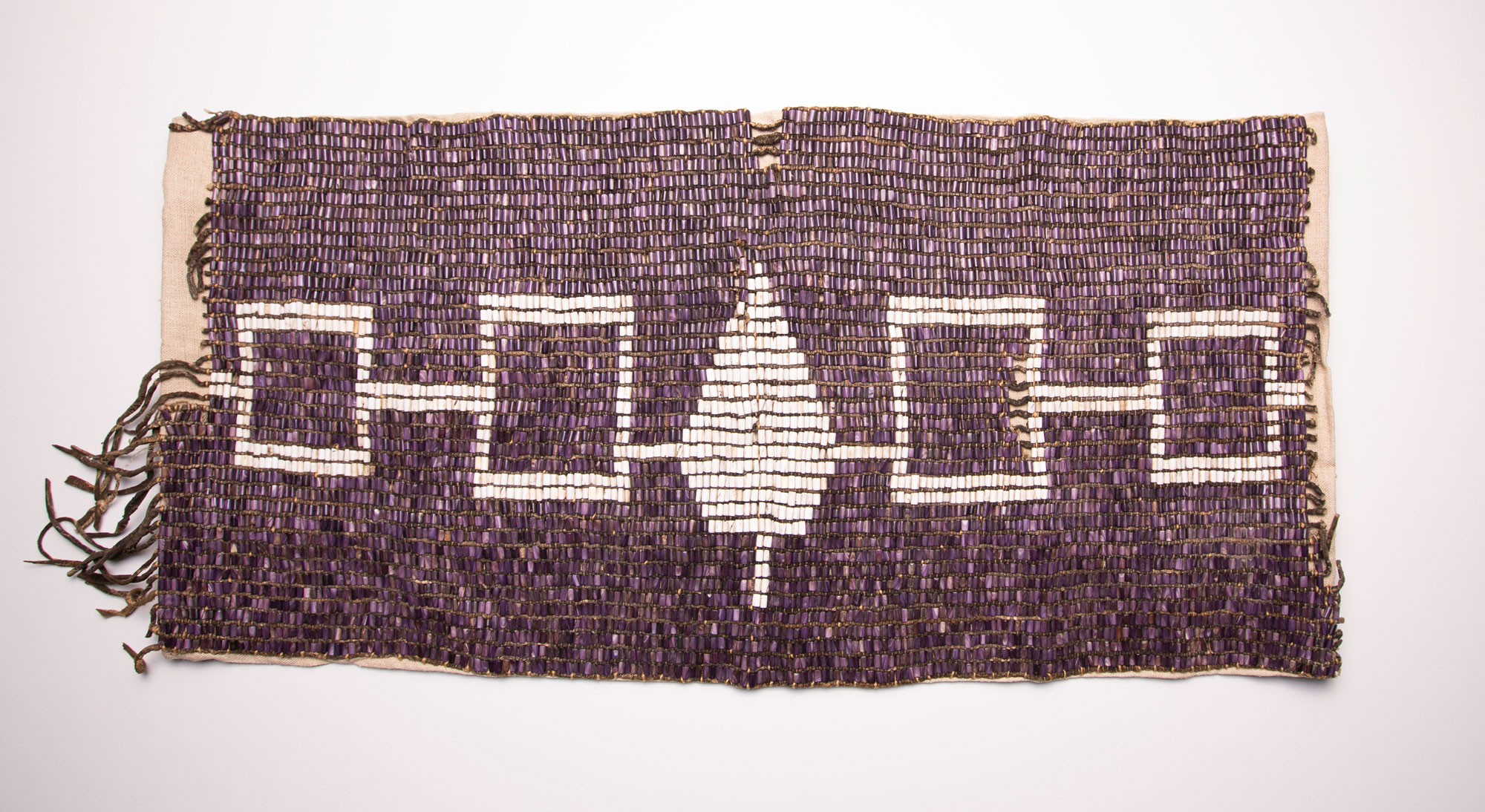

The Great Law of Peace is an agreement among the Haudenosaunee Confederacy, which included the Mohawk, Onondaga, Oneida, Cayuga, Seneca, and Tuscarora Peoples in eastern Turtle Island. The exact origin date of the agreement is unclear, as various accounts disagree by a period of roughly 400 years (as early as 1142, and as late as 1540). However, what is clear is that The Great Law of Peace and the Haudenosaunee Confederacy predate European contact and already existed in Indigenous Deep Time.
Brokered by Dekanawidah the Peacemaker and recorded in wampum, The Great Law of Peace outlines rules for interactions between the members of the Confederacy and with outside communities (Knutson 2.5). In particular, The Great Law provides insight into the important role of women in upholding the interest of the people of their clans, as matriarchs and as people whose decisions and recommendations influence the politics and leadership of the Confederacy. With respect to gender and the role of women, The Great Law dictates the “lineal descent of the people of the Five Nations shall run in the female line. Women shall be considered the progenitors of the Nation. They shall own the land and the soil. Men and women shall follow the status of the mother” (Wilkins Section 44). This law suggests the Haudenosaunee operate based on a matriarchal system, and, since women own the land and the soil, men are the ones to move to follow their wives. Despite its emphasis on matriarchal lineage, The Great Law specifies gendered practices in decision-making that value the opinion of men and women equally: section 95 states, “The women of every clan of the Five Nations shall have a Council Fire ever burning in readiness for a council of the clan. When in their opinion it seems necessary for the interest of the people they shall hold a council and their decisions and recommendations shall be introduced before the Council of the Lords by the War Chief for its consideration,” while section 94 states, “The men of every clan of the Five Nations shall have a Council Fire ever burning in readiness for a council of the clan. When it seems necessary for a council to be held to discuss the welfare of the clans, then the men may gather about the fire. This council shall have the same rights as the council of the women” (Wilkins). These laws suggest that while men and women are responsible for different aspects of life within the Confederacy - women for the interest of the people, and men for the welfare of the clans, ultimately both genders have important roles in upholding the community. The establishment of the Haudenosaunee Confederation was venerated in wampum, which are beads made from pierced seashells that are strung together in specific colours and patterns. Wampum marks agreements (Knutson 2.5). As related on the Onondaga Nation’s website, “the shell is considered a living record of the Haudenosaunee. The speaker puts the words of the agreement into the wampum as the strings are woven together. Each speaker therefore uses the wampum to remember the initial agreement and the history that has happened after that date” (www.onondaganation.org/culture/wampum). As such, the wampum belt of the Haudenosaunee Confederation demonstrates an exchange of communication and non-written recorded language. The Great Law of Peace of the Haudenosaunee Confederacy exemplifies many aspects in which pre-contact Indigenous communities of Turtle Island actively participated in global exchange. It is a record of the spread of ideas about politics, power, and social organization across six Indigenous communities. It is also evidence of trade among the Indigenous Nations of the Haudenosaunee Confederacy, as well as their trade with adjacent communities.
Jamāl al-Dīn al-T.Ibī (1232 – 1306) and the Pearl Trade during the Mongol Period
Chabi, wife of Kublai Khan (founder of the Yuan Dynasty), 14th century. Artist: Araniko (1245 - 1306).

In the image “Chabi, wife of Kublai Khan, 14th century,” the subject is depicted wearing an elaborate headdress and earrings, adorned with countless white pearls. Additionally, the lapel of her top also appears to be embroidered with small white pearls. In Mongol culture, pearls were cherished in jewelry making and medicine due to their rarity (Knutson 1.11). Further, white pearls were prized because the colour white is associated with good fortune and charisma (Gill 177). These aesthetic consumer choices, largely driven by the wives of Mongol rulers, allowed the Iraqi trader Jamāl al-Dīn al-T.Ibī (1232 – 1306) to monopolize the pearl trade and the export of pearl-based jewelry from Baghdad to the Mongol Empire to sell to the women of the Mongol elite. It’s also what allowed him to eventually amass enough resources and influence to move into the even more lucrative trade of exporting high-quality Arabian horses via maritime routes to the far East (Knutson 1.11).
During the 14th century, much of modern day China was controlled by the Mongols, who founded the Yuan Dynasty. To promote trade, the Mongols established the ortogh system - a borrowed Turkic word meaning “partner” - to work with merchants in order to facilitate the movement of imported goods (Knutson 1.11). For merchants, being in partnership with the Mongols meant protection and access to official relay stations when traversing long distances. It also meant elevated social status and the opportunity to enter into even more substantial trade partnerships with the Mongol elite (Knutson 1.11). During the Mongol period, pearls traveled across the globe with merchants like Jamāl al-Dīn via both land and ocean routes. In the pearl trade network in which Jamāl al-Dīn was involved, pearls were often purchased as raw material from the Island of Kish, famous for pearl hunting, then transported inland to Baghdad to be pierced and otherwise processed, before then being transported to Kish once again to be loaded onto ships. From there, rather than sailing directly to China from Kish, Jamāl al-Dīn made detours to other pearl production sites along the Indian Ocean Basin, including the Swahili coast of southeast Africa and the kingdom of Ma ‘bar in South India (Gill 179). The pearl trade is an example of how the ortogh system helped merchants like Jamal al-Din al-TIbi accumulate enormous wealth, while facilitating the spread of materials and visual cultures, which depended on the consumer interests of Mongol elite women like Chabi. The journey of the pearls, first as raw materials, then as jewelry created away from their place of origin, only to be sold and traded elsewhere under the protection of the Mongol Empire, is evidence of global connections in which privilege and luxury goods created policies and economic demands that inspired wider global economic transactions.
Qutulun (c. 1260 – 1360 CE)
Combat de Qutulun, fille de Qaïdu, surnommée Aiyurug, ‘lune brillante’. Le Livre de Marco Polo, chapitre 196, manuscrit BnF fr. 2810, fol. 95v.

This image was drawn by French painter Maître de la Mazarine (completed 1410 – 1412 CE). It is a European depiction of Mongol noblewoman Qutulun (c. 1260 – c. 1360 CE), wrestling with a suitor. This image appeared in Livre des merveilles, an account of the travels of Marco Polo (1254 – 1324 CE), published between 1400 – 1420 CE. Notably, the painting was completed and the book was published well after the death of the subject and the man who first relayed her story. The image is an interpretation of the life story of Qutulun, a Mongol noblewoman who was a powerful warrior, wrestler, and military leader who excelled in battle. Qutulun was the most famous daughter of Qaidu (1230 – 1301 CE), a Mongol ruler from the Ögedeids family (Knutson 1.9). Unlike her sisters, Qutulun was allowed to choose her own husband, using a selection process she devised herself – she would only marry a man who could beat her at wrestling, while the price of his defeat was 100 horses. In 1280 CE, Marco Polo described her wrestling match with the son of a powerful king seeking her hand, who risked 1000 horses and lost. This story later became the subject of the painting at hand (Knutson 1.9).
From 1206 to the mid-1400s, the Mongols, led by and following the legacy of Ghengis Khan, conquered much of the Eurasian continent. Notably, between 1237 - 1241, the Mongols expanded their raids into Eastern Europe and as far as modern day Poland, Hungary, and Germany, leaving a mark on European imaginations as ruthless and fierce invaders from the East. Against this larger historical backdrop, Marco Polo’s travel stories depicting his observations of Mongol culture and customs became a subject of fascination in Europe, as evidenced by the popularity of his travel stories and the imaginative yet Eurocentric artistic renditions that accompany his text. There are several liberties taken with artistic interpretation. Firstly, every person depicted in this painting has European features, including light skin, light hair, and European-styled clothing. Secondly, we know the Mongols lived nomadic lifestyles, while the building in the background is clearly from a sedentary culture, featuring columns perhaps inspired by Roman architecture. These inaccuracies are perhaps due to the artist hearing the story second- or even third-hand, since Marco Polo was long dead before the painting was created. It is also possible that these artistic choices reflect a purposeful appropriation of Qutulun’s story into European narratives. In any case, this rendition suggests a lack of understanding of Mongol culture and customs, and instead, a fascination with the story of Qutulun itself. From this perspective, the story of a Mongol noblewoman becomes the cultural export itself, as entertainment for the consumption of European audiences, in lieu of more tangible material or political exchanges common to global history. As such, this painting frames the Mongols as curiosities and as a subject of fascination, while popularizing topical and superficial understandings of Mongol culture that add to and perpetuate European imaginings of Mongol culture, at arm's length. Qutulun’s life story contributed significantly to European understandings of Mongol culture, however loose the European interpretation of Mongol culture might be at the time. It is clear that as an individual from a distinguished family, Qutulun was afforded the resources, training, and other privileges that, in combination with her natural talents and hardwork, allowed her to challenge and defeat men of similar social status, power, wealth. However, we must also acknowledge that her lived experiences are the exception, not the rule: Qutulun’s life story signifies what was possible for women in Mongol society, but the possibility was far from the average experience, even compared to the lives of her sisters. Nevertheless, the story of Qutulun, immortalized in Mazarine’s painting, is an example of Mongol society in European imaginations which demonstrates how global history is not simply the exchange or spread of tangible material goods, but cultural stories as well.
The Story of Ojegeh (c. 1400)
The story of Ojegeh, as retold by Dr. Tessie Naranjo, a Santa Clara Pueblo Elder, details her community’s migration in the early 1400s, following the Little Ice Age, ca. 1300. The Ancestral Pueblo peoples are indigenous to what is known today as New Mexico in the United States. The Santa Clara Pueblo, in particular, belong to the Tewa linguistic group (Naranjo 255). They were advanced farmers who had created irrigation canals, dams, and terraces to enhance their agriculture by as early as 300 CE (Knutson 2.7). Due to the limited productivity of the land, the Ancestral Pueblo Peoples were reliant on extensive trade networks for foodstuffs, as well as salt, stones for toolmaking, and prestige goods such as animal hides and turquoise (Knutson 2.7). Their trade routes extended as far as Mesoamerica, and led to the Ancestral Pueblo People’s adoption of Mesoamerican religious figures like the Quetzalcóatl, the Feathered Serpent god. It also led to the spread of cultural goods and practices, such as rubber balls and the games the Maya played with them, and the transportation of wildlife, such as the scarlet macaw, some 1100 miles from their natural habitat.
Due to population growth after 700 CE, the Ancestral Pueblo Peoples built communal villages that consisted of adjoining buildings made with large sandstone blocks in two of the densest settlements, Mesa Verde and Chaco Canyon. By 1000 CE, Chaco Canyon’s population exploded, leading to more and larger pueblos that cumulatively, housed a population of approximately 6000 people (Knutson 2.7). There were extensive roads between Chaco Canyon and at least 70 other communities throughout the Colorado River Plateau, covering an area of 10,000 square miles. These vast and robust trade networks facilitated the transport of different materials across long distances, including coastal shells and timber (Knutson 2.7). Two periods of drought from 1130 - 1180 and from 1275 - 1300, followed by the Little Ice Age (c. 1300), resulted in reduced crops and a period of scarcity and human migration in the region. This history is the context for the story of Ojegeh, a Tewa woman who is credited as the originator of the Santa Clara Pueblo. Ojegeh was an orphan who was much gossiped about, and was later accused of witchcraft. She was asked to leave her community after it suffered a series of misfortunes, including the death of children in the community, and the failure of crops (Naranjo 255). After she was driven out by gossip, Ojegeh established her own settlement by a river, which grew as people from her old community slowly began to join her in settling there, over the span of years (Naranjo 256). This new settlement would become the Santa Clara Pueblo (Naranjo 255). The Tewa story of Ojegeh is an example of how a history of migration during Indigenous deep time was remembered and passed down through oral tradition before European contact. It also provides the context for migration, which would otherwise be difficult to know for historians and archaeologists who are not part of the community. In particular, the details about the community’s hardships corroborates both the period of scarcity due to climate change, and the archaeological evidence that major centres like Mesa Verde and Chaco Canyon were abandoned shortly before, in the 1300s. Finally, Ojegeh, as a woman who led her community to a new settlement, demonstrates the power of women as matriarchs whose words and actions have immense influence over the migration decisions of a Tewa community.
Anonymous. “Three Seated Statues from Oyo.” The Human Record: Sources of global history, to 1500, edited by Alfred J. Andrea and James H. Overfield. Boston: Cengage Learning, 2015. 354-357. Araniko. Chabi, wife of Kublai Khan (founder of the Yuan Dynasty). 14th century, National Palace Museum, Taipei. Paint and ink on silk. Black, J.A., Cunningham, G., Fluckiger-Hawker, E, Robson, E., and Zólyomi, G. “The Exaltation of Inanna (Inanna B): Translation”. The Electronic Text Corpus of Sumerian Literature (http://www-etcsl.orient.ox.ac.uk/), Oxford 1998- . Covington, Richard. "Lost and Found: Ancient gold artifacts from Afghanistan, hidden for more than a decade, dazzle in a new exhibition." Smithsonian Magazine, Sept. 2008. Smithsonian Magazine, www.smithsonianmag.com/arts-culture/lost-found-7605081/. Accessed 14 Jan. 2025. Gill, Matanya. "9. Jamāl al-Dīn al-T. ībī: The Iraqi Trader Who Traversed Asia". Along the Silk Roads in Mongol Eurasia: Generals, Merchants, and Intellectuals, edited by Michal Biran, Berkeley: University of California Press, 2020. 175-193. Knutson, Sara Ann. “Lecture 1.3: Sumer and Babylonia.” History 101. 16 September 2024. University of British Columbia, Vancouver. Lecture. Knutson, Sara Ann. “Lecture 1.6: Silk Road Networks: Bactria and Persia.” History 101. 07 October 2024. University of British Columbia, Vancouver. Lecture. Knutson, Sara Ann. “Lecture 1.8: Societies of the Central Asian Steppes.” History 101. 21 October 2024. University of British Columbia, Vancouver. Lecture. Knutson, Sara Ann. “Lecture 1.9: The Mongols.” History 101. 28 October 2024. University of British Columbia, Vancouver. Lecture. Knutson, Sara Ann. “Lecture 1.11: Islamic Commerce and Global Exchanges.” History 101. 18 November 2024. University of British Columbia, Vancouver. Lecture. Knutson, Sara Ann. “Lecture 2.1: West African Kingdoms I.” History 101. 06 January 2025. University of British Columbia, Vancouver. Lecture. Knutson, Sara Ann. “Lecture 2.5: Turtle Island.” History 101. 03 February 2025. University of British Columbia, Vancouver. Lecture. Knutson, Sara Ann. “Lecture 2.7: Ancestral Pueblo Peoples and the Taíno.” History 101. 24 March 2025. University of British Columbia, Vancouver. Lecture. Liu Shang. “Eighteen Songs of a Nomadic Flute.” The Human Record: Sources of global history, to 1500, edited by Alfred J. Andrea and James H. Overfield. Boston: Cengage Learning, 2015. 262 - 265. Mazarine, Maître de la. Combat de Qutulun, fille de Qaïdu, surnommée Aiyurug, 'lune brillante'. Naranjo, Tessie. “Life as Movement: A Tewa View of Community and Identity.” The Social Construction of Communities: Agency, Structure, and Identity in the Prehispanic Southwest, edited by Mark D. Varien and James M. Potter, 2008. 251-263. Wilkins, David E. (Ed). Documents of Native American Political Development: 1500s To 1933. Oxford: Oxford University Press, 2009.


